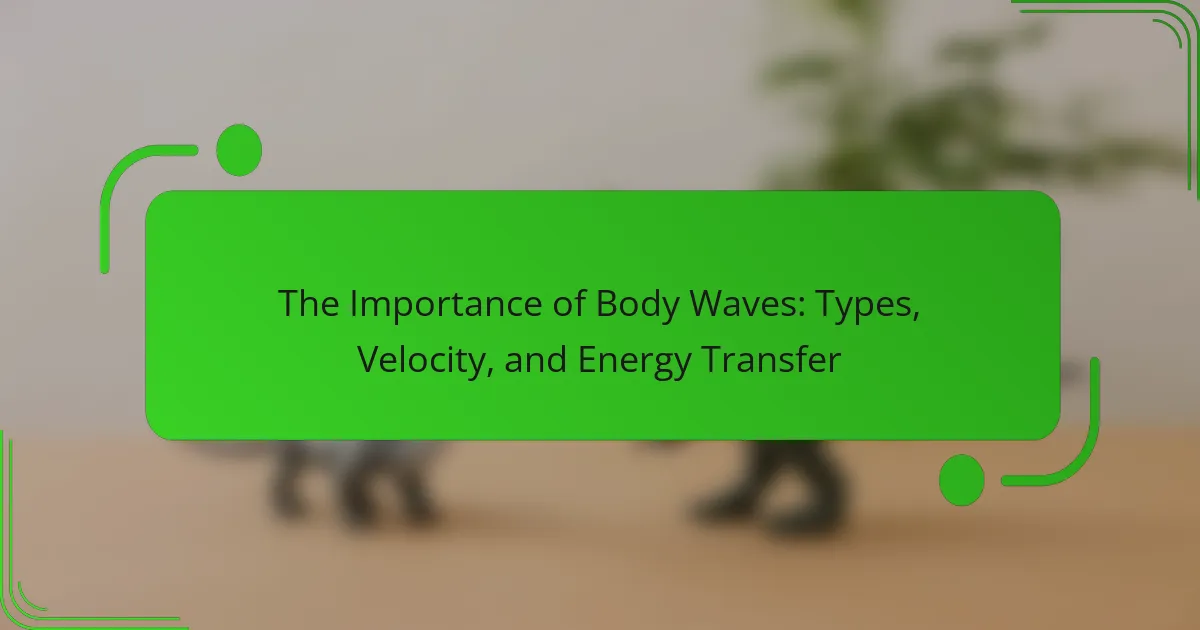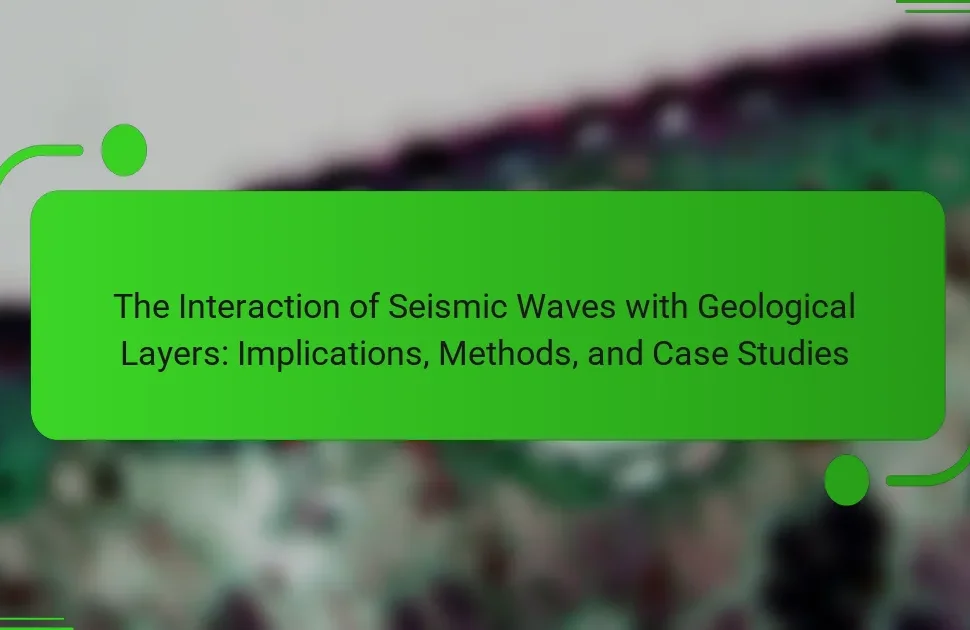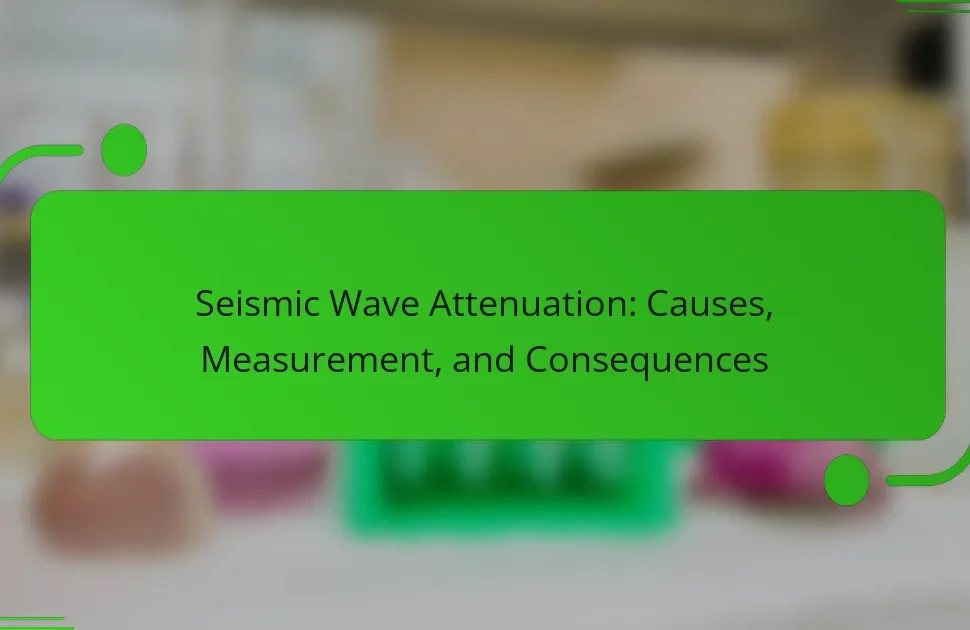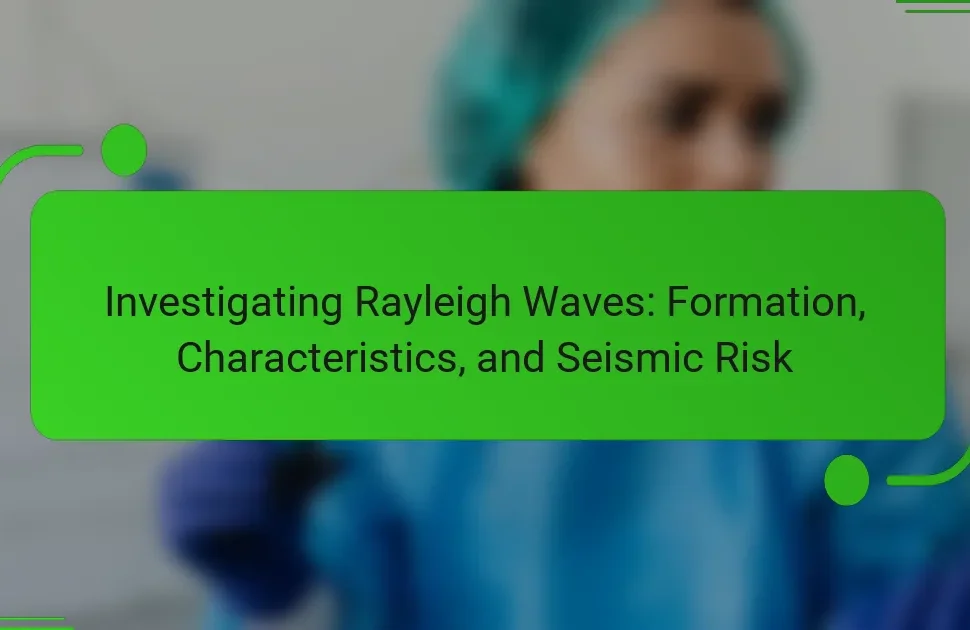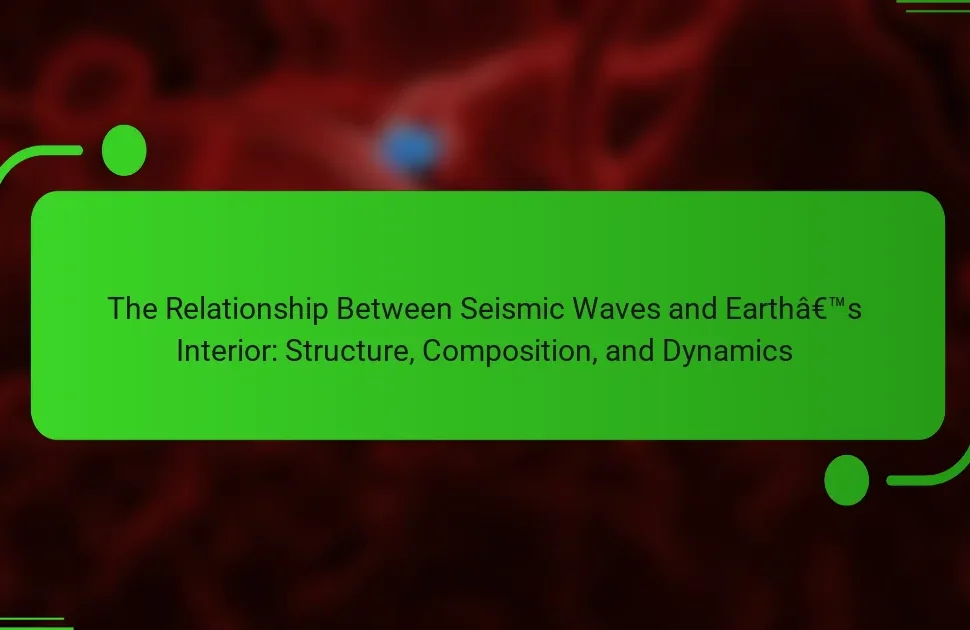Body waves are seismic waves that travel through the Earth’s interior and are essential for understanding its structure and behavior during seismic events. There are two primary types of body waves: primary (P) waves, which are compressional and can move through solids, liquids, and gases, and secondary (S) waves, which are shear waves that only travel through solids. The study of body waves aids seismologists in determining earthquake locations and magnitudes, as well as providing insights into the Earth’s internal composition and tectonic movements. Factors influencing body wave velocity include the medium’s density, elasticity, and temperature, with P waves generally traveling faster than S waves. Body waves have practical applications in seismology for earthquake preparedness and in medical imaging techniques like ultrasound.

What are Body Waves and Why are They Important?
Body waves are seismic waves that travel through the interior of the Earth. They are crucial for understanding the Earth’s structure and behavior during seismic events. Body waves are classified into two types: primary (P) waves and secondary (S) waves. P waves are compressional waves that move faster and can travel through solids, liquids, and gases. S waves are shear waves that only move through solids and are slower than P waves.
The study of body waves helps seismologists determine the location and magnitude of earthquakes. By analyzing the arrival times of these waves at seismic stations, scientists can infer the Earth’s internal composition. Body waves also provide insights into tectonic plate movements and the dynamics of the Earth’s crust. Their importance lies in advancing our knowledge of geophysical processes and enhancing earthquake preparedness.
How do Body Waves differ from other types of waves?
Body waves differ from other types of waves in that they travel through the interior of the Earth. They are primarily categorized into two types: primary waves (P-waves) and secondary waves (S-waves). P-waves are compressional waves that move faster than S-waves, which are shear waves. Unlike surface waves, which travel along the Earth’s surface, body waves can penetrate deeper layers. Body waves are crucial for understanding the Earth’s structure and are utilized in seismic studies. Their velocity varies based on the material they traverse, with P-waves traveling faster in denser materials. This distinction is fundamental in seismology for locating and analyzing earthquakes.
What are the key characteristics of Body Waves?
Body waves are seismic waves that travel through the interior of the Earth. They are primarily categorized into two types: P-waves and S-waves. P-waves, or primary waves, are compressional waves that move faster than S-waves. They can travel through solids, liquids, and gases. S-waves, or secondary waves, are shear waves that only move through solids. They are slower than P-waves. Body waves are crucial for understanding the Earth’s internal structure. They provide information about the composition and state of materials within the Earth. Their speed varies depending on the medium they travel through, with P-waves being the fastest at approximately 5 to 8 km/s in the Earth’s crust. S-waves travel at about 60% of the speed of P-waves.
Why is understanding Body Waves essential in various fields?
Understanding body waves is essential in various fields such as geology, seismology, and engineering. Body waves are seismic waves that travel through the Earth’s interior. They help in determining the Earth’s internal structure and composition. In seismology, analyzing body waves allows scientists to locate and measure earthquakes. This understanding aids in predicting seismic hazards. In engineering, knowledge of body waves informs the design of structures to withstand earthquakes. It ensures safety and minimizes damage during seismic events. Studies show that effective building designs can reduce earthquake-related risks significantly.
What are the different types of Body Waves?
Body waves are seismic waves that travel through the Earth’s interior. There are two primary types of body waves: P-waves and S-waves. P-waves, or primary waves, are compressional waves that move through solids, liquids, and gases. They are the fastest seismic waves, traveling at speeds of about 5 to 8 kilometers per second in the Earth’s crust. S-waves, or secondary waves, are shear waves that can only move through solids. They travel slower than P-waves, at speeds of about 3 to 4.5 kilometers per second. The distinct properties of P-waves and S-waves allow seismologists to determine the Earth’s internal structure.
What defines Primary Waves (P-Waves)?
Primary Waves, or P-Waves, are the fastest type of seismic wave. They travel through solids, liquids, and gases. P-Waves are compressional waves, meaning they cause particles in the medium to move back and forth in the same direction as the wave. This motion creates areas of compression and rarefaction. P-Waves are the first waves detected by seismographs during an earthquake. Their speed can reach up to 8 kilometers per second in the Earth’s crust. This rapid movement allows them to provide crucial information about the earthquake’s location and intensity.
What defines Secondary Waves (S-Waves)?
Secondary Waves (S-Waves) are a type of seismic wave that moves through the Earth during an earthquake. They are characterized by their shear motion, which means they displace the ground perpendicular to their direction of travel. S-Waves can only propagate through solid materials, not liquids or gases. This limitation allows scientists to use S-Waves to infer the composition of the Earth’s interior. Their velocity is slower than that of Primary Waves (P-Waves), typically ranging from 60 to 70% of the speed of P-Waves. S-Waves arrive after P-Waves during an earthquake, providing crucial data for understanding seismic events. Their presence indicates that the material they pass through is solid, confirming that the outer core of the Earth is liquid, as S-Waves do not travel through it.
How do Body Waves contribute to energy transfer?
Body waves contribute to energy transfer by transmitting seismic energy through the Earth’s interior. These waves, including primary (P) and secondary (S) waves, propagate differently. P-waves are compressional waves that travel faster and can move through solids and liquids. S-waves are shear waves that only travel through solids.
As these waves move, they carry energy from the source of an earthquake to distant locations. The energy transfer occurs as the waves cause particles in the Earth to vibrate. This vibration generates ground motion, which can be measured by seismographs.
Research shows that body waves account for a significant portion of the energy released during seismic events. For instance, approximately 80% of the energy from an earthquake is released as body waves. This demonstrates their essential role in the overall energy transfer process during seismic activities.
What mechanisms facilitate energy transfer through Body Waves?
Body waves transfer energy through two primary mechanisms: compression and shear. Compression occurs when particles in a medium are pushed together, creating areas of high and low pressure. This mechanism is characteristic of primary waves or P-waves. Shear involves the sideways movement of particles, which is typical of secondary waves or S-waves.
Both mechanisms rely on the elastic properties of the medium. For instance, when seismic waves travel through the Earth, they cause the ground to vibrate. This vibration is a direct result of the energy transfer facilitated by body waves. Studies indicate that P-waves travel faster than S-waves, which is crucial for understanding seismic events. The difference in velocity is due to the nature of the particle movement in each wave type.
How does the velocity of Body Waves impact energy transfer?
The velocity of body waves directly influences energy transfer during seismic events. Faster body waves can transmit energy more efficiently through the Earth’s interior. This increased velocity allows energy to travel greater distances in shorter timeframes. As a result, regions farther from the seismic source can experience shaking sooner.
The two main types of body waves, P-waves and S-waves, have different velocities. P-waves, which are compressional waves, travel faster than S-waves, which are shear waves. For instance, P-waves can reach speeds of approximately 6 km/s in the Earth’s crust, while S-waves travel at about 3.5 km/s.
This difference in velocity affects how energy is distributed during an earthquake. Areas closer to the epicenter feel the effects of P-waves first, followed by S-waves. Consequently, understanding body wave velocity is crucial for predicting the impact of seismic events.

What factors influence the velocity of Body Waves?
The velocity of body waves is influenced by several key factors. These factors include the medium’s density, elasticity, and temperature. Denser materials typically slow down wave velocity. Conversely, increased elasticity allows waves to travel faster. Temperature also plays a role; higher temperatures can reduce density and increase velocity. Additionally, the type of body wave affects its speed. Primary waves (P-waves) travel faster than secondary waves (S-waves). The relationship between these factors is well-documented in seismic studies. For instance, P-waves can travel through solids, liquids, and gases, while S-waves only move through solids. This distinction highlights the importance of material properties in determining wave velocity.
How does medium affect the speed of Body Waves?
The medium significantly affects the speed of body waves. Body waves travel faster in solids than in liquids and gases. This is due to the density and elasticity of the medium. For example, seismic P-waves travel at approximately 5 to 7 km/s in granite, while they travel around 1.5 km/s in water. The denser and more rigid the medium, the quicker the waves propagate. In contrast, the speed decreases in less dense materials. This relationship is critical in understanding seismic wave behavior during earthquakes.
What role does density play in the velocity of Body Waves?
Density inversely affects the velocity of body waves. As density increases, the velocity of these waves typically decreases. This relationship is due to the mass and stiffness of the medium. Higher density means more mass per unit volume. This added mass resists the wave’s propagation. Consequently, waves travel slower through denser materials. Conversely, in less dense materials, waves can move more quickly. This principle is supported by the wave equation, which shows that velocity is proportional to the square root of stiffness divided by density. Thus, density plays a crucial role in determining the speed of body waves in different media.
How do temperature and pressure influence Body Wave velocity?
Body wave velocity is influenced by both temperature and pressure. As temperature increases, the velocity of body waves generally increases. This occurs because higher temperatures reduce the density of the medium, allowing waves to travel faster. Conversely, as pressure increases, body wave velocity also increases. Increased pressure compresses the medium, enhancing wave propagation speed.
In solid materials, the relationship between temperature, pressure, and wave velocity is well-documented. For instance, in seismic studies, researchers observe that seismic wave velocities increase with depth due to both temperature and pressure effects. The empirical relationship is often modeled using equations derived from the principles of elasticity and thermodynamics.
Why is the study of Body Wave velocity significant?
The study of Body Wave velocity is significant because it helps in understanding the Earth’s internal structure. Body Waves, including P-waves and S-waves, provide insights into seismic activity. Their velocities vary depending on the material they travel through. For example, P-waves travel faster in solid materials than in liquids. This velocity data aids in locating earthquake epicenters. It also helps in assessing the composition of geological formations. Understanding Body Wave velocity can improve earthquake prediction models. Enhanced prediction models can lead to better disaster preparedness and response strategies.
How does Body Wave velocity aid in earthquake analysis?
Body Wave velocity aids in earthquake analysis by providing critical information about the earthquake’s location and magnitude. Body waves, which include primary (P) waves and secondary (S) waves, travel through the Earth’s interior. Their velocities differ, with P waves traveling faster than S waves. By measuring the arrival times of these waves at seismic stations, scientists can determine the distance to the earthquake’s epicenter.
The velocity of P waves typically ranges from 5 to 8 kilometers per second, while S waves travel at approximately 3 to 4.5 kilometers per second. This difference in velocity allows for the calculation of the time interval between the arrival of P and S waves. This interval is crucial for estimating the earthquake’s depth.
Additionally, analyzing body wave velocity helps in understanding the geological structures involved in the earthquake. Variations in wave speed can indicate different materials in the Earth’s crust and mantle. This information is vital for assessing seismic hazards and improving building codes in earthquake-prone areas.
What applications utilize Body Wave velocity in geophysics?
Body Wave velocity is utilized in various applications within geophysics. One primary application is seismic exploration for oil and gas. This method uses Body Wave velocity to identify subsurface geological formations. It helps in locating hydrocarbon reservoirs efficiently. Another application is in earthquake seismology. Body Wave velocity aids in determining the location and magnitude of seismic events. Additionally, it is used in engineering geology. Here, Body Wave velocity assesses ground stability for construction projects. Lastly, it plays a role in environmental studies. Body Wave velocity helps in characterizing groundwater flow and contamination. These applications underscore the significance of Body Wave velocity in understanding Earth’s subsurface.

What are the practical implications of Body Waves in real-world scenarios?
Body waves have significant practical implications in various real-world scenarios. They are crucial in seismology for understanding earthquakes. Body waves help in locating the epicenter of seismic events. They also provide data on the Earth’s interior structure. This information is vital for constructing safer buildings in earthquake-prone areas. Additionally, body waves are used in medical imaging techniques, such as ultrasound. Ultrasound utilizes body waves to create images of internal organs. This application aids in diagnostics and monitoring of health conditions. Body waves thus play a key role in both geological and medical fields.
How can understanding Body Waves improve safety in construction?
Understanding body waves can enhance safety in construction by providing insights into subsurface conditions. Body waves, including primary (P) and secondary (S) waves, help in assessing soil stability. Engineers can use seismic surveys to detect potential hazards like liquefaction or fault lines. This knowledge allows for better foundation design and risk mitigation. For instance, studies show that seismic data can predict ground movement, which is crucial for safety. Accurate assessments reduce the likelihood of structural failures during construction. Therefore, understanding body waves is vital for informed decision-making in construction projects.
What measures can be taken to mitigate risks associated with Body Waves?
Mitigating risks associated with Body Waves involves implementing several safety measures. First, monitoring seismic activity can provide early warnings of potential hazards. Second, constructing buildings with seismic-resistant designs can reduce structural damage during earthquakes. Third, conducting regular safety drills prepares individuals for emergency situations. Fourth, educating communities about the risks of Body Waves enhances public awareness and preparedness. Lastly, establishing emergency response plans ensures efficient action during seismic events. These measures collectively contribute to minimizing the impact of Body Waves on human safety and infrastructure.
What best practices should be followed for studying Body Waves?
To study body waves effectively, researchers should follow systematic methodologies. First, utilize appropriate seismic equipment to ensure accurate data collection. This includes seismographs for measuring wave amplitudes and frequencies. Second, analyze wave propagation in diverse geological settings to understand variations in velocity and energy transfer. Third, conduct controlled experiments to simulate body wave behavior under different conditions. Fourth, collaborate with geophysicists to interpret data and validate findings. Finally, regularly review current literature to stay updated on advancements in body wave research. These practices enhance the reliability and relevance of body wave studies.
How can researchers effectively measure Body Waves?
Researchers can effectively measure Body Waves using seismographs. These instruments detect ground motion caused by seismic waves. Seismographs record the amplitude and frequency of the waves. This data helps in analyzing wave characteristics. Researchers can also use accelerometers for precise measurements. Accelerometers capture changes in velocity over time. This method is beneficial for studying wave propagation. Additionally, numerical modeling can simulate body wave behavior. These simulations provide insights into wave interactions with geological structures. Together, these methods enhance understanding of Body Waves.
What tools and technologies are essential for Body Wave analysis?
Essential tools and technologies for Body Wave analysis include seismographs and accelerometers. Seismographs measure ground motion and record seismic waves. Accelerometers detect changes in velocity and can capture wave propagation. These instruments provide data on wave characteristics and behavior. Advanced software is also critical for analyzing the recorded data. This software helps in visualizing waveforms and interpreting results. Additionally, computational models simulate Body Wave behavior under various conditions. These models aid in understanding wave interactions with geological structures. Together, these tools and technologies enable comprehensive Body Wave analysis.
Body waves are seismic waves that travel through the Earth’s interior, playing a crucial role in understanding the Earth’s structure and behavior during seismic events. The article explores the two primary types of body waves: primary (P) waves, which are faster and can move through solids, liquids, and gases, and secondary (S) waves, which are slower and only travel through solids. Key characteristics, velocity factors, and their impact on energy transfer during seismic activities are examined, highlighting their significance in fields such as geology, seismology, and engineering. The practical implications of body waves in earthquake analysis and construction safety are also discussed, emphasizing their importance in enhancing disaster preparedness and response strategies.
